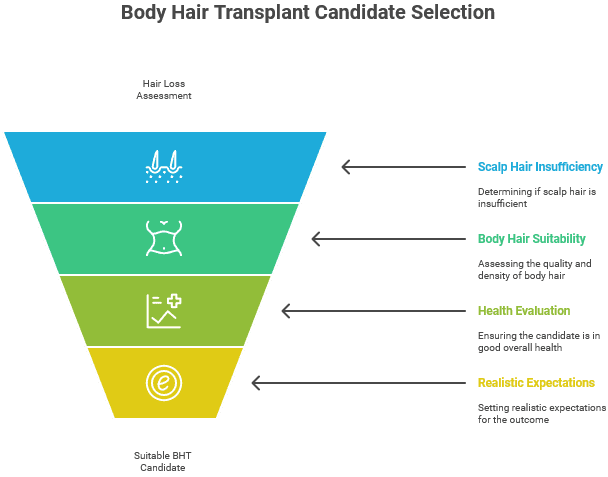Traditional hair transplant procedures like hair plugs are completely outdated. With new advancements like Follicular Unit Extraction (FUE) and Follicular Unit Transplant (FUT), more and more people with hair loss are considering resolving their issues with surgery. Many people are not fans of losing their hair and are willing to explore options to regain their youthful look.
If you are experiencing the late stages of male pattern baldness, you might think it’s over, but you’re wrong. Today, we will discuss the body hair transplant procedure and help you determine if you are a good fit.
When Scalp Hair Isn’t Enough
The best hair transplant results occur when the patient has enough healthy hair follicles on their scalp, which is considered the best donor area for all types of hair transplants. However, in severe male pattern baldness cases, there will not be enough healthy hair follicles to extract from the scalp. Luckily, this is not the end of the story, as there are a few new ways to tackle the issue.
One of them is to use healthy hair on your body and transplant it to your head. It’s called a body hair transplant, so let’s start by defining it.
What Is a Body Hair Transplant (BHT)?
The Body Hair Transplant (BHT) procedure explores alternate donor sites to extract healthy hair follicles and transplant them to your scalp. Granted, most will say that the result will not be as natural-looking as with patients who still have thick hair at the sides and back of their head, but one thing is for sure. It will be much better than being bald.
The results might surprise you if you go with a highly skilled surgeon. They will calculate the right number of grafts to extract and transplant to your scalp to make it look like you never lost your hair.
Before making phone calls and sending scheduling requests, let’s determine if you are a good fit for this procedure.
Who Is a Good Candidate for Body Hair Transplants?
If you are completely bald or getting close to it, you probably do not have enough hair follicles in your scalp area. However, if you have robust body hair characteristics like thick and dense body or beard hair that matches the length, curl, and caliber of your natural hair, you are suitable for body hair transplants. Surgeons can use the FUE technique to extract hair follicles from that area and place them on your scalp with the FUT procedure.
In addition, you need to focus on realistic expectations and talk to your surgeon about them. Finally, it is preferable that you have good overall health before you go into surgery. If you meet all these criteria, then you can start scheduling appointments.
Pros | Cons |
|---|---|
Expands donor supply | Lower survival rates |
Offers options | Different textures |
Repairs hair after accidents | Less natural results |
Covers scars | Requires skilled surgeon |
Where Can Body Hair Be Taken From?
As you might have imagined, not all body hair suits the procedure. In most cases, there will be a good and a bad alternative. Let’s consider the two most common options.
Beard Hair Transplants: The Best Non-Scalp Option
Beard hair grows and behaves similarly to regular hair. It’s not entirely the same, as it might feature more thickness and different growth and curling patterns. Still, if you are completely bald and there are no healthy hair follicles to extract with the FUE method from your head, then your beard will be the next best source to consider as a donor area. Your beard grows in longer cycles than other types of body hair, which can help improve your hair density in the mid-scalp or crown area.
Chest Hair, Leg Hair, and Other Body Hair
If getting hair from your beard is not an option, surgeons can consider other types of body hair as a secondary option. However, the results here are inferior. Hair growth in these areas is much different than what happens on our heads. The growth patterns and growth cycles are different, and your chest and leg hair are much weaker than your regular hair or beard. Therefore, the results will not be as natural as you might have hoped.
Of course, with a skilled surgeon by your side, you can always expect to get the best possible outcome. They will also brief you and keep your expectations within reason.
So, Is BHT Right for You?
If you think you are a good candidate and will feel much better about yourself after a hair transplant, then yes, BHT is right for you. To save costs, you can explore getting a hair transplant in Turkey to save a pretty penny. The cost of flying there, staying at a hotel, and getting surgery is much more affordable than going to a US surgeon, and the quality of the procedure might even be superior in Turkey than in the US.
In Turkey, several types of procedures can be combined. For example, a beard hair transplant can be combined with chest and leg hair to get as close as possible to a full head of hair. Talk to your chosen surgeon and explore your options.

FAQs
How Successful Are Body Hair Transplants?
They are moderately successful, but you can increase your chances if you are a good candidate with healthy beard hair. It is also imperative to pick an experienced surgeon who will slowly guide you through the process.
What are the Risks and Challenges of BHT?
If you are a good candidate, you are not risking anything. However, if you are not an ideal candidate but still decide to go under the knife with only chest and leg hair follicles available, you risk a result that will simply not look like a full head of hair, even remotely.
What are the Pros and Cons of Using Body Hair for Transplants?
BHT expands the donor supply area and gives people with hair loss issues options to explore. This type of surgery is excellent if you want to repair parts of your hair after an accident or to cover a scar. However, the cons are that body hair has lower survival and growth rates, different textures, curls, and lengths, and it offers less natural results.

